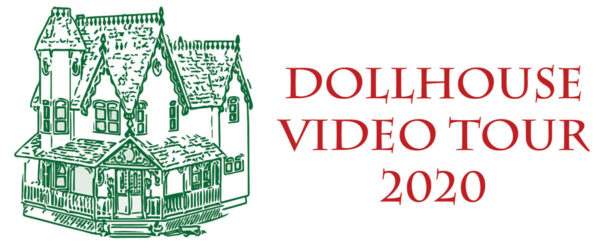
Because of COVID-19 in 2020 our annual Housewalk was cancelled. Instead, we offered this online video tour of dollhouses that are either part of our collection or owned by friends of the society. It was a huge fundraising event and we thank everyone who donated to this project. Now, as we try and get back to some normalcy and prepare for our Housewalk 2021 tour of homes in Mount Prospect, we gratefully offer these videos to watch again, as well as all of the information about this project found on the navigation menu above. This is part of our commitment to “Keeping Hometown Memories Alive.”
As you watch the videos download the Dollhouse I Spy Activity Sheet and see if you can find the items listed. (Click here)
Edwardian Eclectic Dollhouse
Welcome to the Edwardian Eclectic Dollhouse! This house was handmade by Charles Semft in 1905 as a Christmas present for his granddaughter, Erns Keller. Erns moved to Mount Prospect as an adult. The dollhouse is made of sturdy mahogany and has a distinctive hipped roof with two gabled windows and two chimneys. The curling porch and stair railing are painted wrought iron. Much like full-size homes, this dollhouse has undergone some interior remodeling over the years, particularly in the 1970s or later.
The front door opens right into the kitchen. Here the appliances have stayed true to the early 1900s, though the rainbow wallpaper matches more with the 1970s aesthetics of their current residents, the Sunshine Family. Instead of a modern refrigerator, members of the Sunshine family keep their food cold the old-fashioned way: in an icebox. Iceboxes relied on regular deliveries of large ice blocks to continue keeping food cool, but visits from the iceman were no longer necessary in the 1950s when electric refrigerators had largely replaced iceboxes. Hopefully the Sunshine family still has a local iceman to refill their icebox! The Queen Anne brand cast iron stove, another early 1900s appliance, is essential to preparing many of the family’s meals. From there, meals are served on the antique kitchen table, made by the same man who built the house.
The blending of Edwardian and 1970s designs is most obvious in the parlor. The Sunshine family painted the walls this bright shade of yellow and added the bold midnight blue polka dot carpet. Some of the more colorful accessories, like the heart-shaped pillow on the chaise lounge, is also from them. However, this family appreciates antiques. They still use the original leather chaise lounge and secretary desk. Both of these pieces were made with the wood from a cigar box. One fixture that ties together past and present is this little green plastic oil lamp. It’s a product of the 1970s Edwardian revival for its use of new materials, plastic, to make an old-fashioned object, an oil lamp.
On the upper floor is the attic bedroom. The wall-to-wall carpeting, added sometime in the 1970s or 80s, is from local carpet manufacturer Galaxy Mills, Inc. Their headquarters were on Arthur Avenue in Elk Grove when this carpet was purchased. Other prominent furnishings in this room are the two metal beds with scrollwork that match the designs on the front porch railings. A large trunk at the foot of the bed holds spare curtains and other household linens. Though this is a large dollhouse with spacious rooms, you may have noticed by now that there is no bathroom. True to its early 20th century real-life counterparts, this dollhouse does not have an indoor bathroom. Instead of a sink, this floral pitcher and bowl set on the washstand are available for the family’s morning and bedtime routines.
Thank you for taking a tour of the Edwardian Eclectic Dollhouse with us! We sincerely appreciate your support for the Mount Prospect Historical Society.
1930s Dollhouse
The Great Depression and the Dust Bowl made the 1930s a decade of great hardship for many Americans. In the middle of these challenges, however, children and adults still found ways to have fun. Dollhouses were just as popular in the 1930s as they had been earlier in the century, but better mass production made them and their furniture more financially accessible to families with a limited income. Cheaper materials, like cardboard, also helped keep dollhouse and furniture prices low. This handmade dollhouse, dated November 5, 1932, is made of wood, making it a little unusual for its time.
The red living room set is the most distinctive set in the entire house. Not only is it on a slightly smaller scale than the rest of the furniture, it’s Art Deco furniture. Art Deco was a design style popular during the 1920s, 30s, and 40s that embraced geometric and linear motifs, rich colors, and overall bold designs. It’s often associated with The Great Gatsby and 1920s flappers. Dollhouse experts believe that Jaymar Specialty Company’s Happy Hour line of dollhouse furniture may have been the first American company to bring Art Deco style to dollhouses. This living room set is part of that Happy Hour line from the early 1930s. The geometric designs on the furniture and the staircase shape of the chairs and sofa are all hallmarks of Art Deco.
These red chairs around the green and white table add a pop of color to the house. In fact, dollhouse furniture of the 1930s was usually sold in a rainbow of colors. A child may have furnished their dollhouse with a yellow kitchen, a green dining room, or a red living room. However, most furniture sets of the 1930s would have come in matching colors, meaning this table and these chairs may have been repainted or may belong to different sets.
This white wooden bathroom set may seem pretty ordinary, except for the toilet. Low-profile toilets like this one, both in miniature and full-size forms, are part of the transition from an outdoor outhouse to an indoor bathroom. You may have seen toilets from the early 1900s with tank high above the bowl; the toilet in this dollhouse is an example of how the tanks lowered as plumbing improved.
The furniture in the attic might be handmade or modified pieces of store-bought sets. There are details on these pieces that don’t entirely match pieces of known 1930s dollhouse furniture. There are pencil markings at the bottom of both bed’s footboards, suggesting that someone cut out the final shape. Each mattress is supported by slats across the bed rails, but most store-bought dollhouse beds of this time have one solid piece of wood across the entire length. The chairs all have leather seat cushions, which are also not common on store-bought dollhouse furniture. Whether these furnishings were modified or entirely handmade, they demonstrate the creative ways that dollhouse owners personalized their miniature homes.
This green dining room set was part of the first dollhouse furniture collection produced in the early 1930s by Strombecker Manufacturing Company, a wooden toy company in Moline, Illinois. Each dining room set included four chairs (one of ours is missing), a table, and a buffet on a roughly one-inch scale. Though the scale is somewhat large, the furniture doesn’t neglect detail. The turned table legs and the carved chair backs add originality to the mass-produced furniture. Importantly, Strombecker dollhouse furniture was relatively inexpensive compared to other brands and therefore, it was a more reasonable purchase for families impacted by the Great Depression.
Thank you for taking a tour of this 1930s dollhouse with us! We sincerely appreciate your support for the Mount Prospect Historical Society.
Judy Connelly’s Dollhouse
In 1945, Colleen Moore’s Fairy Castle captured the imagination of 10-year-old Judy Connelly as she joined crowds to see its magical rooms displayed in the windows of Marshall Field’s in Chicago. Judy was so inspired by Colleen Moore’s dollhouse that she asked for and received this Rich Toy dollhouse the following Christmas.
Since 1945 Judy’s dollhouse has traveled throughout Illinois and Indiana and undergone numerous careful unpackings and repackings so that each new generation can enjoy playing with it. Currently this dollhouse is in Mount Prospect under the care of Judy’s daughter, Julie Michalik. Her and her husband, Joel, have been restoring and updating it in honor of Judy’s 85th birthday.
The dollhouse is filled with a mix of original and new furnishings. The dining room set, bar cart, and fireplace in the living room and dining room all date to the 1940s. The plastic Renwal brand desk set under the stairs has been personalized with Judy’s iconic red box. Her real-life red box contains all the information she needs to keep track of changing addresses and important dates in the lives of her family and friends. Some of the most recent changes include opening up the wall between the living room and dining room, installing a new staircase, and restoring the original oatmeal beige color of the interior walls. Julie also added family photos throughout the house, including a 2020 family photo along the staircase. These photos are a beautiful tribute to all the family members who have cared for this dollhouse over the years.
Most kitchens need updated appliances after 75 years, but not this one! The sink, stove, and toaster are still in working order. One exception is the refrigerator. It was recently replaced because it wasn’t keeping food cold anymore.
At the top of the stairs is the master bedroom. Judy’s grandfather carved the bed and the nightstand, which look right at home next to the newer furniture. The little girl in the photo above the staircase is Judy, the first dollhouse owner. Please pardon the mess in this room! The dollhouse residents have been hard at work preparing for Christmas at the wrapping station.
The bathroom fixtures are all original to the dollhouse. Modern additions, like the mirror and hutch, complement the existing layout. It’s well stocked with the essentials, too.
The kid’s room is Julie’s favorite. All of the furnishings are new, except for the baby buggy. She made many of the miniature toys, and her husband built the bed.
Julie and Joel added an attic at the top of the house. Here they display the Pretty Princess brand nursery furniture from 1945 alongside other miscellaneous pieces collected over the years.
Thank you for taking a tour of Judy Connelly’s Dollhouse with us! We sincerely appreciate your support for the Mount Prospect Historical Society.
The Chalet (1960s-70s)
Welcome to The Chalet! This dollhouse was inspired by Swiss chalet architecture, with a mid-century modern twist. For only $6.99, or $8.94 in the 1975 Sears Wish Book, a child could buy this fully furnished dollhouse.
The only catch to this deal is that an adult would have to assemble the fiberboard dollhouse with the included nuts and bolts. The Brumberger Manufacturing Company of New York produced The Chalet and other dollhouse models between 1965 and 1975. Innovations in mass-production just before this time period made this dollhouse more affordable than many of its predecessors.
One of those mid-20th century innovations was the use of plastic furnishings. Plastic furniture, like the pieces here in the living room, could be made on a smaller scale, in more detail, and more consistently than wood furniture. The corner bookcase, with its stack of books clearly visible between two horsehead bookends, is a good example of the new possibilities of plastic.
The kitchen and dining room showcase some late 1960s and early 1970s design trends. The walls of the dining room are covered in wood paneling and matching wall sconces set off the large pastoral painting. All of these elements draw inspiration from Colonial Revival style. The kitchen floor is covered in robin’s egg blue speckled tiles. If this kitchen was life-size, the tiles probably would have been made of vinyl, a newly popular flooring material in the 1960s.
At the top of the modern staircase is the bathroom. The avocado green and golden yellow floor tiles are iconic colors of this era. In a real house, the tiles may have matched the fixtures and even the toilet paper! The bathtub in the corner resembles a hot tub, but it’s actually called a Cinderella bathtub. This compact square style was popular throughout the middle of the 20th century.
One of the most noticeable elements of this bedroom is the striking shade of blue on the walls and carpet. We’ve already seen some bold colors in this dollhouse, but the printed shag carpet makes this room extra stylish by mid-20th century standards. During this carpet’s heyday it showcased the industry advancements that had made wall-to-wall carpeting more affordable and more colorful than ever before.
The roof overhang creates a small shelter on the side of the dollhouse called a carport. It’s not an entirely enclosed space, but it provides a car some protection from the elements and storage for backyard tools. This element is also a Midwestern design feature. Architect Walter Burley Griffin included the first documented carport in the 1909 home of William and Jennette Sloane in Elmhurst.
Thank you for taking a tour of this chalet dollhouse with us! We sincerely appreciate your support for the Mount Prospect Historical Society.
Atwood Manor
This is the house that Margie Atwood built. It’s a miniature replica of the home on Kensington Road where she lived with her husband, Clarence, and their daughter, Mary Ann. By the time this dollhouse was completed in 1981, she had been a resident there for almost 40 years and in that time witnessed the surrounding area transform from farmland to a suburban neighborhood.
Atwood Manor, as Margie called it, was a childhood dream come true. Margie dreamed of having her own dollhouse all her life, and when she was in her 70s she finally decided to build her own. She began this project with only basic crafting skills, no carpentry experience, and a lot of enthusiasm. All her hard work clearly paid off in this beautiful dollhouse.
The furniture throughout the house is a mix of handmade pieces and store-bought ones. The grandfather clock, sofa and chair, and several paintings here in the living room and dining room are some of Margie’s handmade pieces. The most difficult piece to build was the staircase bannister, according to her comments in a 1982 Daily Herald article. Others, like this side table, bookcase, and china cabinet still have a price sticker from Frank’s Nursery and Crafts.
All of the flooring, including this tiled kitchen, was installed by Margie herself. In fact, the only element that required outside assistance was the electricity. Lights throughout the house are wired through the floors and ceilings to the step-down transformer hidden in the attic.
At the top of the staircase, a door opens into the bathroom. The handmade pink sink, toilet, and bathtub might seem a bit bold to modern day visitors, but the style was popular throughout the decades when the Atwood family lived here. The earthy colors of the wallpaper and the bright blue shag rugs also serve as a reminder of popular styles when Margie was building the dollhouse in the late 1970s and very early 1980s.
The daughter’s room is filled with color! The Tiffany-inspired lamp even adds a rainbow glow to the white dresser. Of course, the most exciting feature in this room is the toy box. It’s stuffed with dolls, ducks, and even a pumpkin. Raggedy Ann sits to one side of the box, and a giant teddy bear looks quite comfortable in the opposite corner.
The master bedroom features a matching white wood bed, vanity, and dresser set. Of course, Margie made her own mark on this room too. The dresser is actually two smaller dressers stuck together. She also stitched the curtains and the pink satin bedspread and pillow. Throughout the entire dollhouse it’s obvious that this project was a labor of love for Margie Atwood.
Thank you for taking a tour of Atwood Manor with us! We sincerely appreciate your support for the Mount Prospect Historical Society.
21st Century Dollhouse
Mount Prospect residents Shirley and Bud Budris built and furnished this dollhouse in 2000, making it the most modern dollhouse in the Mount Prospect Historical Society collection. Though it’s only twenty years old, it is rooted in historic traditions.
The Budris dollhouse was not intended to be a toy for children, but rather something for adults to enjoy. It would be considered a hobbyist’s project today and, around 400 years ago, European men and women would have recognized it as a “baby house.” Despite the name, baby houses were not children’s toys, but essentially large display cases for wealthy European women’s collections of miniatures. These women invested a great deal of time and money into furnishing their miniature houses so that each room reflected their sophistication and high social status.
Shirley and Bud clearly put the same level of dedication into this beautiful dollhouse. The entire house is lit with electric lights and each piece of furniture was crafted by a miniature artist or purchased from a specialty shop. The immense detail makes it easy to imagine yourself right there in the house, perhaps curled up with a book next to the family cat in the living room or taking a seat at the kitchentable to have some tea and freshly made pastries. The kitchen is stocked with all sorts of utensils and ingredients to make a wonderful meal. If you look closely, you might recognize some of the products in the cabinets!
Just up the stairs is the master bedroom. This room evokes a spring garden with its light pink and dark green color scheme. The floral design in the wallpaper, the green furniture, and the miniature flowers around the room all reflect this theme. The headboard even looks inspired by a garden gate!
What are little boys made of? Snakes and snails and puppy dog tails, according to the bed’s headboard! This little boy seems to have taken that saying to heart; his room reflects the outdoors. The furniture is constructed of picket fence boards painted with tree branches and grass, and a few animals too. Two boys and their dog, perhaps Tom Sawyer and Huck Finn, stroll across the footboard of the bed towards the nearest fishing pond. Even the toys scattered across the room add to the theme, from the big red barn dollhouse to the animal figurines lined on the shelf above the bed.
Double doors open into the bathroom, complete with sink, toilet, and shower stall.
At the very top of the house is the study. It’s a reader’s paradise! There are books on every subject on the shelves across the back wall. Scattered between the books are intriguing knick-knacks and framed pieces of art. One image you might recognize in these shelves is The Birth of Venus, by Botticelli. If you’ve been to the Art Institute of Chicago, the two paintings on opposite sides of the room may also seem familiar. The piece above the couch is Sunday Afternoon on the Island of La Grande Jatte by Seurat. The one above the desk is Young Woman at an Open Half-Door by Rembrandt. This study would be the perfect place to spend an afternoon, whether that be curled up on the couch with a good book and a pot of tea, or writing Christmas cards at the desk, near the warmth of the blazing fire.
Thank you for taking a tour of this 21st century dollhouse with us! We sincerely appreciate your support for the Mount Prospect Historical Society.





